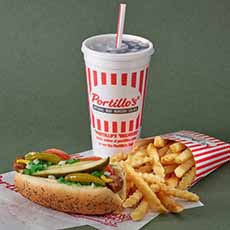Portillo’s Garden Dog: A Plant-Based Hot Dog, Dressed To Kill
|
|
It seems that every burger chain now has a plant-based burger, but what about the hog dogs? Hot dog lovers are finally getting a plant-based version of the iconic Chicago-style dog at Chicago-based fast-casual chain Portillo’s. According to the National Hot Dog and Sausage Council, Americans eat more than 7 billion hot dogs every year during ‘peak hot dog season,’ between Memorial Day and Labor Day. Portillo’s wants vegetarians, vegans, and others who don’t eat meat that its first-ever plant-based hot dog is ready to roll—or is that, ready in a roll? The chain has 70 outposts across nine states and is expanding, bringing their new meatless dog nationwide (see the locations). The meatless dog, made by quality vegan meat pioneer Field Roast (long a NIBBLE favorite), is the best plant-based dog on the market, and was chosen by Portillo’s after tasting dozens of contenders. Called the Garden Dog, the plant-based hotdog is now available at Portillo’s restaurants nationwide. The “dog” in question is the Field Roast Signature Stadium Dog which we wrote about last year. It’s been custom-crafted for Portillo’s and topped with the same classic Chicago-style hot dog toppings as Portillo’s regular dog: mustard, relish, chopped onions, tomatoes, celery salt, pickle spear, and sport peppers, on a steamed poppy seed bun. Take a bite: You won’t even know that it isn’t a conventional hot dog, that’s how good it is. It is dee-licious! The dog, made for Portillo’s by Field Roast, a leader in premium grain-based meat alternatives, is a pea protein-based hot dog inspired by the flavors of premium, kosher-style beef hot dogs. Unlike other products that use liquid smoke, the dogs are double smoked using maple hardwood chips and a combination of steam and dry heat. The plant-based hot dog also offers the same amount of protein per serving as most traditional hot dogs, but contains less sodium and is made without nitrites or GMOs. Already available at retail stores nationwide, the Stadium Dog has been transformed into a Chicago-style Garden Dog at Portillo’s, with those great Chicago-dog toppings. Portillo’s established its reputation in Chicago as a hot dog stand in the 1960s, and today is known for its hot dogs, Italian beef sandwiches and chocolate cake at its more than 70 locations across nine states. In the beginning, there was the frankfurter, or Frankfort-style sausage, a slender pork sausage popularized in Frankfurt, Germany. But first, there were Viennese sausages. The hot dog traces its lineage to the 15th-century Viennese sausage, or Wienerwurst in German. In the 17th century, Johann Georghehner, a butcher from the German city of Coburg, in Bavaria, is credited with inventing the “dachshund” or “little dog” sausage and bringing it with him to Frankfort—hence, a Frankfort sausage, which became frankfurter in the U.S.; and the word wiener was also used. Both names still referred to a sausage eaten with a knife and fork like other German sausages—no bun. The hot dog, a slender sausage in a bun, was undeniably an American invention. The attribution is given to a German immigrant named Charles Feltman, who began selling grab-and-go sausages in rolls at a stand in Coney Island in 1871. The 1893 World Exposition in Chicago marked the debut of the hot dog vendor. According to National Hot Dog and Sausage Council, it was around this time that the hot dog made its first appearance at a ballpark, at a St. Louis Browns game. The first published mention of the term “hot dog” as a food (as opposed to a canine) first appeared in print in a September 1893 issue of The Knoxville Journal. Here’s more history of the hot dog. What about brats? Brat is short for bratwurst, a type of German sausage that’s wider than a hot dog. Here’s more about the difference between bratwurst and hot dogs. The main differences between a frankfurter and a hot dog are the ingredients and flavors. German sausages are pork- and veal-based. Lamb-producing countries make lamb sausage, countries with seashores make seafood sausages. While the U.S. offers every kind of hot dog, from beef to pork, to beef-pork blends, to poultry, the majority of hot dogs tend to be all beef or a mixture of meat trimmings from beef and/or pork. There are also “gourmet” hot dogs made from high-end pork like Berkshire and Kurobuta, and beef versions made from Kobe and Wagyu. The main differences between a hot dog and a sausage are the production process and seasonings. Here’s what’s in the typical beef hot dog. The most common spices used in hit digs include allspice, cinnamon, coriander, cumin, garlic, nutmeg, paprika, and pepper (black, red, and white) [source]. |
|
|
CHECK OUT WHAT’S HAPPENING ON OUR HOME PAGE, THENIBBLE.COM.
|
||








